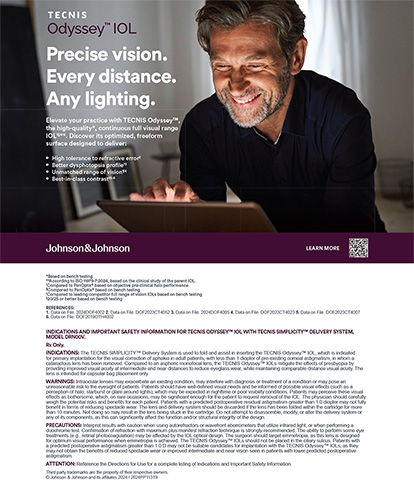
A patient came in for an annual examination, and, when asked how he was doing, he responded: “Every morning I wake up and I open two gifts.” The patient went on to explain how the eyes are among the greatest privileges that a person can have because they provide the opportunity to see and enjoy the world in which he or she lives.
I think that most surgeons love hearing comments like this from their patients, as it truly gives meaning to the phrase 20/happy. Ironically, this particular patient had map-dot-fingerprint dystrophy and soft confluent drusen in the macula. His BCVA after cataract surgery was 20/50. Despite his compromised vision, the patient expressed gratitude and satisfaction with the quality of his life and the vision that he enjoyed.
Unfortunately, not all patients feel this way, and one of the hardest challenges for ophthalmologists is to manage those who do not share these sentiments and are quite often dissatisfied with their visual outcome despite objective findings of uncorrected 20/20 vision. Pleasing these patients often requires patience, time, energy, and, sometimes, a degree in refractive psychology. The ability to handle these challenging patients is one of the most difficult things to learn and master—even more difficult than mastering the surgical procedure that delivered the great outcome. Irrespective of 20/happy or 20/unhappy, we are ultimately moving toward a system in which we are not judged by patient happiness, but rather by the outcomes we deliver in terms of a measurable metric of visual acuity.
With ever-changing regulations, CMS guidelines, and the Merit-based Incentive Payment System (MIPS) criteria, we are forced to comply with postoperative visual acuity standards for our patients. This is a complex metric. There are so many pre-, intra-, and postoperative factors that can ultimately determine a patient’s postoperative BCVA. Furthermore, BCVA is only part of the story, and it has only partial bearing on how well the patient is functioning in his or her life and how satisfied he or she is in the care that was provided.
With its Intelligent Research in Sight (IRIS) registry, the AAO is looking to partner with the CMS to report surgeon outcomes for achieving MIPS criteria. There is currently a 20/40 standard benchmark for successful postoperative visual acuity after cataract surgery. However, modifications are being considered to change it to an even higher standard—20/20. Of course, this would not apply to patients who have preexisting ocular conditions—especially those who have significant visual compromises such as severe corneal disease, macular degeneration, diabetic retinopathy, optic nerve disease, or advanced glaucoma. However, there are other, more subtle conditions that may not manifest themselves so easily such as map-dot-fingerprint dystrophy, irregular astigmatism, dry eye, mild epiretinal membranes, and others that can reduce BCVA down to the 20/40 level but still provide a very satisfactory and happy outcome for the patient.
If new criteria are too stringent, and too much emphasis is placed on this sole metric of visual acuity, it could affect ophthalmologists’ abilities to deliver outcomes to these standards and leave them subject to the punitive reimbursement policies put into place by the CMS. Fortunately, the AAO is seeking input from other ophthalmic and government relations organizations to help guide prudent decision-making.
Personally, it would be frustrating for me to have to focus my attention on what could be an unrealistic and unobtainable visual acuity outcome versus doing my best to ensure patients are happy and seeing as well as they can. It also makes me question whether I want to be part of the AAO IRIS registry and whether it is beneficial to my patients and my practice. There are things that happen that are outside our control, and Mother Nature is not always on our side.
Hopefully, this pendulum will swing back and allow us to practice in an environment with a little less regulation and more trust that ophthalmologists do the best they can for patients. However, it takes work; involvement; and a hands-on, active approach to ensure that we protect our ability to spend the time we need with our patients. It is important to have freedom to focus on patient care instead of government regulations and requirements and to have a viable financial model for ophthalmic businesses.




